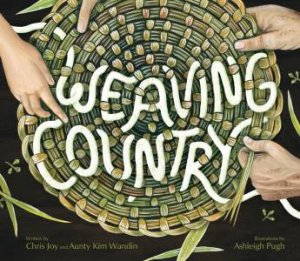Weaving Country by Chris Joy & Aunty Kim Wandin. Illus. by Ashleigh Pugh

When Walert (Possum) sees her Gugung (grandmother) gathering djirra (reeds) by the river, the susurrus through the rushes invites her to follow her home, little knowing that she is going to learn one of those precious lessons that generations share between each other as they pass the knowledge of their culture to each other.
In Walert's case, she not only learns about the physical construction of a woven binak (basket), but also how the sun, land, water and wind all play their part in the growing and the preparation of the djirra so they are ready to weave, strengthening her understanding of her connection to Country that is so integral of First Nations culture and life. And when a boroin (blue wren) builds its tiny nest in the drying djirra, and lays three little eggs, Walert also learns patience. This is not the time to disturb the circle of life that has endured for so long.
This is a story set on Wurundjeri Country in the Yarra Valley, Victoria and based on the work of author Aunty Kim Wandin who is a master weaver and Wurundjeri Woi-wurrung Elder, whose traditional basket making has been handed down to her by direct lineage, so Walert's lessons have authenticity and authority. The teachers' notes which accompany it specifically focus on encouraging "students to slow down, listen deeply, and build respectful relationships with place, themselves, and each other, honouring the wisdom of intergenerational learning and the living stories carried by land and water" offering opportunities to engage with the land, its harvest, its inhabitants and each other that they might not otherwise consider.
But as well as connecting both Walert and the students to their natural environment, the story itself has a strong focus on the passing of knowledge, skills and understandings between Gugung and Walert making it an ideal springboard for helping young readers develop their understanding of the outcomes embedded in the early years of the Australian HASS curriculum. What stories and skills have their grandparents shared with them, such as favourite books, or music, or crafts or how to mend a bike or....??? Is there something that their family always does at a particular commemoration or celebration because that's the way it has always been done? For older students, what stories, traditions and skills will they pass on to their own children?
From 2027 in New South Wales, the Human Society and its Environment K−6 Syllabus (2024) requires students in Stage 1 (years 1 and 2) to understand that “People use stories, images, objects and sites to understand the ancient past” with a specific focus on the ancient cultures of China, Egypt, Greece and Rome, and those in Stage 2 (Years 3 and 4) to focus on the ancient cultures of Mesoamerica which include the Maya, Aztecs and Incas so although their grandparents are not that old, this could be a bridge that helps them understand that much of what they know and do today is built on what those who have gone before have known and done beginning within their own family and their own experience.
While there seems to be an upsurge in the writing and publishing of books that explore First Nations' connections to Country, helping non-Indigenous children understand and appreciate the Welcome to Country and Acknowledgement of Country that are part of their daily lives, this one, through its story and indeed, its literal and metaphorical focus on weaving, is a stand out.
Themes: Storytelling, Sustainability, Biodiversity, Identity, Belonging, Cultural Respect, Wellbeing, Intergenerational learning.
Barbara Braxton